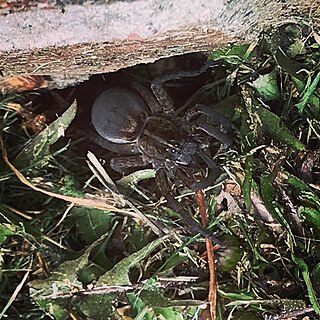
Wolf spiders are members of the family Lycosidae, named for their robust and agile hunting skills and excellent eyesight. They live mostly in solitude, hunt alone, and usually do not spin webs. Some are opportunistic hunters, pouncing upon prey as they find it or chasing it over short distances; others wait for passing prey in or near the mouth of a burrow. Wolf spiders resemble nursery web spiders, but wolf spiders carry their egg sacs by attaching them to their spinnerets, while the Pisauridae carry their egg sacs with their chelicerae and pedipalps. Two of the wolf spider's eight eyes are large and prominent; this distinguishes them from nursery web spiders, whose eyes are all of roughly equal size. This can also help distinguish them from the similar-looking grass spiders.

Tigrosa aspersa is a large wolf spider that inhabits the eastern United States. Compared to its close relative Tigrosa helluo, T. aspersa is much larger. This species was known as Hogna aspersa prior to 2012, when it was moved to Tigrosa.

Lycosa tarantula is the species originally known as the tarantula, a name that nowadays in English commonly refers to spiders in another family entirely, the Theraphosidae. It now may be better called the tarantula wolf spider, being in the wolf spider family, the Lycosidae. L. tarantula is a large species found in southern Europe, especially in the Apulia region of Italy and near the city of Taranto, from which it gets its name.

Lycosa is a genus of wolf spiders distributed throughout most of the world. Sometimes called the "true tarantula", though not closely related to the spiders most commonly called tarantulas today, Lycosa spp. can be distinguished from common wolf spiders by their relatively large size. This genus includes the European Lycosa tarantula, which was once associated with tarantism, a dubious affliction whose symptoms included shaking, cold sweats, and a high fever, asserted to be curable only by the traditional tarantella dance. No scientific substantiation of that myth is known; the venom of Lycosa spiders is generally not harmful.

Myrmaplata plataleoides, also called the red weaver-ant mimicking jumper, is a jumping spider that mimics the Asian weaver ant in morphology and behaviour. This species is found in India, Sri Lanka, China and many parts of Southeast Asia.

Dolomedes tenebrosus or dark fishing spider is a fishing spider found in the United States and Canada.

Dolomedes scriptus is a fishing spider found in the United States and Canada, known as the striped fishing spider. Female spiders can grow to be over 6 cm in legspan. The spider is a pale brown colour with lighter stripes around its legs and a stripe down each side of the body. It is similar to D. tenebrosus.

Allocosa brasiliensis is a burrowing wolf spider species from southern South America. Long known to science, it remained almost unstudied until its unusual sexual behavior was described in the early 21st century.

Hogna carolinensis, commonly known as the Carolina wolf spider and giant wolf spider, is found across North America. It is the largest of the wolf spiders in North America, typically measuring at 18–20 mm for males and 22–35 mm for females.
Lycosa indagatrix is a species of spiders of the genus Lycosa native to India and Sri Lanka. The species is about 22 mm long. The habitats include tunnels and burrows and it is a purely nocturnal spider.
Draposa is a genus of wolf spiders in the family Lycosidae, containing ten species. The species were formerly included in genus Pardosa, but later included in the new genus Draposa.

Tigrosa is a genus of spiders in the family Lycosidae, found in North America.

Lycosa aragogi is a species of the araneomorph spider family Lycosidae endemic to Kerman Province, Iran. The female holotype measured 26mm,, with two black and three white stripes of setae on its cephalothorax, black setae on its chelicerae, and scattered dots and patterns of black and white setae on its abdomen.

Anoteropsis hilaris, commonly referred as the garden wolf spider or the grey wolf spider, is a species of wolf spider that is endemic to New Zealand.
Halocosa is a genus of wolf spiders first described by G. N. Azarkina and L. A. Trilikauskas in 2019. As of December 2021 it contains only three species: H. cereipes, H. hatanensis, and H. jartica. The type species, Halocosa cereipes, was originally described under the name "Lycosa cereipes".
Karakumosa is a genus of Asian wolf spiders first described by Dmitri V. Logunov and A. V. Ponomarev in 2020.
Serratacosa is a genus of wolf spiders. It was first described by L. Y. Wang, X. J. Peng and Z. S. Zhang in 2021, and it has only been found in China. As of January 2022 it contains only three species: S. himalayensis, S. medogensis, and S. multidontata.

Lycosa erythrognatha is a species of spider from the genus Lycosa. The species was originally described in 1836. It is the only spider known to feed on Rhinella ornata.
Schizocosa rovneri is a species of wolf spider found in the United States. Its habitat is primarily leaf litter along floodplains.
Lycosa shillongensis is a species of spiders of the genus Lycosa native to India In India this spider is reported from Manipur, Meghalaya and West Bengal.











